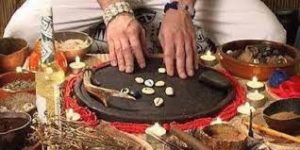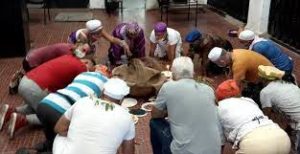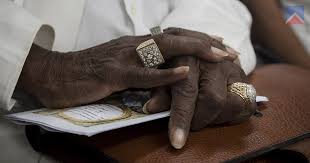AFRO-CUBAN YORUBA, ITS CULTURAL TRADITION. HISTORY OF THE “LETTER OF THE YEAR” (LA LETRA DEL AÑO)
The Ceremony of the “Letter of the Year” is the most important religious event that is carried out by the Babalawos, both in Cuba and Nigeria, although on different dates, so it should be known to all people who care about the Yoruba culture.
We do not question, nor will we ever question what the brothers of the different religious branches do within their Ilé Osha, both in Cuba and in the world; They deserve all respect and consideration for the identity and differentiation that they may have according to their cultural codes.
Cuba is the territory where the cultural traditions of this religion that were bequeathed to us by our slave ancestors brought from Africa at the end of the 18th century are best preserved. This is largely due to the slaves belonging to the Yoruba ethnic group, specifically those of the Orishas and Ifá religions. In our country this religion is considered as a Cuban Religion of African Origin, taking into account, throughout history, the traditional elements rescued by our religious population; elements that have been preserved and revitalized and that due to their popular attachment have become part of our culture and our national identity.
HISTORY OF THE “LETTER OF THE YEAR”. (LA LETRA DEL AÑO).
Since its inception, research has said that the Letter of the Year began to be drawn at the end of the 19th century, without being able to specify the exact date. By data and documents, it is revealed to us that Babalawos from the different religious branches existing in the country began to meet to carry out the established ceremonies with all rigor, which ended on January 1 with the opening of the Letter of the Year.
Through the Oracle of Ifá, the guidelines and recommendations that had to be fulfilled during that year were made known, in order to avoid or overcome obstacles and difficulties. For this reason, the first Letter of the Year that took place in Cuba was made by the Babalawo Remigio Herrera (Obara Meyi, Adeshina), of African origin, supported mainly by five of his godchildren, namely: Marcos García (Ifalola- Baba Ejiogbe ); Oluguere (Oyeku meji); Eulogio Rodríguez (Tata Gaitán-Ogundafun); José Carmen Batista (Obeweñe); Salvador Montalvo (Okaran Meji) and Bernardo Rojas (Ireteuntendi). It is good to note that some of Adeshina’s godchildren had Oluguere as Oyurbona who was also of African origin.
In 1902, due to Adeshina’s health problems, Tata Gaitán assumed responsibility for the Letter of the Year supported by the aforementioned Babalawos and also participating: Secundino Crucet (Osaloforbeyo); Bernabé Menocal (Baba Ejiogbe); Quintín Lecón García (Oturaniko) and José Asunción Villalonga (Ogundamasa).
It also had the participation of almost all the Babalawos of those times. Although the ceremony was always carried out with the greatest possible discretion and in private; since in the prevailing government, all this type of African belief practices were considered a common crime within the penal code. For this reason, in the occasional year, they tried to reduce the massive participation of Babalawos and the heads of families were invited with only one of their godchildren.
1959 ARRIVES AND THE LETTER OF THE YEAR IS INHERITED
On May 9, 1959, Bernardo Rojas passed away and his successor, Dr. José Herrera, inherited the deities of Adeshina and the responsibility of the Letter of the Year. Taking into consideration that Joaquín Salazar was the oldest Babalawo and Obá of the branch, Dr. Herrera gave him the direction of the opening of the year; being carried out with the same effectiveness and religious rigor as the previous ceremonies corresponding to the Letter of the Year.
The activities in these years were carried out under the direction of Joaquín Salazar and the Adeshina branch, represented by Dr. José Herrera.
Later, Joaquín Salazar and other elders undertook the task of reorganizing the existing traditional branches again. In this way, participation in the Letter of the Year was again extended to all Babalawos. This is how the following branches, among others, were called: Francisco Villalonga (Ogunda Kete); Ángel Villalonga (Ogundaleni); Adeshina Remigio Herrera (Obara Meji); Fernando Molina (Baba Eyiogbe); Ño Karlo Adebi (Ojuani Boka); Ángel Padrón (Baba Eyiogbe); Pericón Pérez (Ogbe Yono) and Alejandro Domínguez (Osa Guleya).
The lyrics that have been interpreted in the ACYC for some years now, is the one made by the Babalawos of the country with the greatest number of years of initiation and that from the beginning they have done so uninterruptedly until today.
The more traditional branches of the 19th and early 20th centuries were led by African Babalawos who later delegated this responsibility to their Cuban successors.
We do not intend to center or establish traditions, but to defend the legitimacy of those that already exist, tr
AFRO-CUBANA YORUBA, SU TRADICIÓN CULTURAL. HISTORIA DE LA LETRA DEL AÑO.
La Ceremonia de la Letra del Año es el evento religioso más importante que se lleva a cabo por los Babalawos, tanto en Cuba como en Nigeria, aunque en fechas diferentes, por lo que debe ser del conocimiento de todas las personas que se preocupan por la cultura Yoruba.
No cuestionamos, ni cuestionaremos jamás lo que hacen los hermanos de las diferentes ramas religiosas dentro de su Ilé Osha, tanto en Cuba como en el mundo; pues merecen todo respeto y consideración hacia la identidad y diferenciación que puedan tener según sus códigos culturales.
Cuba es el territorio donde mejor se conservan las tradiciones culturales de esta religión que nos fuera legada por nuestros ancestros esclavos traídos desde África a finales del siglo XVIII. Esto se debe en gran medida a los esclavos pertenecientes a la etnia Yoruba, en específico los de las religiones de los Orishas e Ifá. En nuestro país esta religión es considerada como Religión Cubana de Origen Africano teniendo en cuenta, a través de la historia, los elementos tradicionales rescatados por nuestra población religiosa; elementos que han sido conservados y revitalizados y que por su apego popular han llegado a formar parte de nuestra cultura y de nuestra identidad nacional.
HISTORIA DE LA LETRA DEL AÑO.
Desde sus inicios las investigaciones cuentan que la Letra del Año comenzó a sacarse a finales del siglo XIX, sin poder precisar la fecha exacta. Por datos y documentos se nos revela que Babalawos procedentes de las diferentes ramas religiosas existentes en el país comenzaron a reunirse para efectuar con todo rigor las ceremonias establecidas, que concluían el primero de enero con la apertura del la Letra del Año.
A través del Oráculo de Ifá se daban a conocer las orientaciones y recomendaciones que debían cumplirse durante ese año, con el fin de evitar o vencer los obstáculos y las dificultades. Por esta razón la primera Letra del Año que se realizó en Cuba la efectuó el Babalawo Remigio Herrera (Obara Meyi, Adeshina), de origen africano, apoyado fundamentalmente en cinco de sus ahijados, a saber: Marcos García (Ifalola- Baba Ejiogbe); Oluguere (Oyeku meji); Eulogio Rodríguez (Tata Gaitán-Ogundafun); José Carmen Batista (Obeweñe); Salvador Montalvo (Okaran Meji) y Bernardo Rojas (Ireteuntendi). Es bueno señalar que algunos de los ahijados de Adeshina tenían como Oyurbona a Oluguere que era también de origen africano.
En el año 1902, por problemas de salud de Adeshina, Tata Gaitán asume la responsabilidad de la Letra del Año apoyado por los Babalawos antes mencionados y participando además: Secundino Crucet (Osaloforbeyo); Bernabé Menocal (Baba Ejiogbe); Quintín Lecón García (Oturaniko) y José Asunción Villalonga (Ogundamasa).
Igualmente contó con la participación de casi todos los Babalawos de esos tiempos. Aunque la ceremonia siempre se realizaba con la mayor discreción posible y en privado; ya que en el gobierno imperante, todo este tipo de prácticas de creencias africanas estaban consideradas como un delito común dentro del código penal. Por esta razón en algún que otro año se trató de disminuir la participación masiva de Babalawos y se invitaban a los jefes de familia con sólo uno de sus ahijados.
 VIDEOS – LETRA DEL AÑO HISTORIA
VIDEOS – LETRA DEL AÑO HISTORIA
LLEGA EL 1959 Y SE HEREDA LA LETRA DEL AÑO
El 9 de mayo de 1959 fallece Bernardo Rojas y su sucesor, el Dr. José Herrera, hereda las deidades de Adeshina y la responsabilidad de la Letra del Año. Tomando en consideración que Joaquín Salazar era el Babalawo mayor y Obá de la rama, el Dr. Herrera le cede la dirección de la apertura del año; llevándose a cabo con la misma efectividad y rigor religioso que las anteriores ceremonias correspondientes a la Letra del Año.
Las actividades en estos años fueron realizadas bajo la dirección de Joaquín Salazar y la rama Adeshina, representada por el Dr. José Herrera.
Posteriormente Joaquín Salazar y otros mayores se dieron a la tarea de reorganizar nuevamente las ramas tradicionales existentes. De esta forma se volvió a ampliar la participación en la Letra del Año a todos los Babalawos. Es así como fueron llamadas, entre otras, las ramas que siguen a continuación: Francisco Villalonga (Ogunda Kete); Ángel Villalonga (Ogundaleni); Adeshina Remigio Herrera (Obara Meji); Fernando Molina (Baba Eyiogbe); Ño Karlo Adebi (Ojuani Boka); Ángel Padrón (Baba Eyiogbe); Pericón Pérez (Ogbe Yono) y Alejandro Domínguez (Osa Guleya).
La letra que se interpreta en la ACYC hace ya algunos años, es la realizada por los Babalawos del país con mayor cantidad de años de iniciados y que desde su comienzo lo han hecho de forma ininterrumpida hasta la actualidad.
Las ramas más tradicionales del siglo XIX y del comienzo del XX estuvieron dirigidas por Babalawos africanos que después delegaron esta responsabilidad en sus sucesores cubanos.
No pretendemos centrar ni establecer tradiciones, sino defender la legitimidad de las ya existentes, transmitidas de generación en generación.
Agencies/ AsociacionYorubadeCuba/ Internet Photos/ YouTube/ Arnoldo Varona/ www.TheCubanHistory.com
THE CUBAN HISTORY, HOLLYWOOD.










